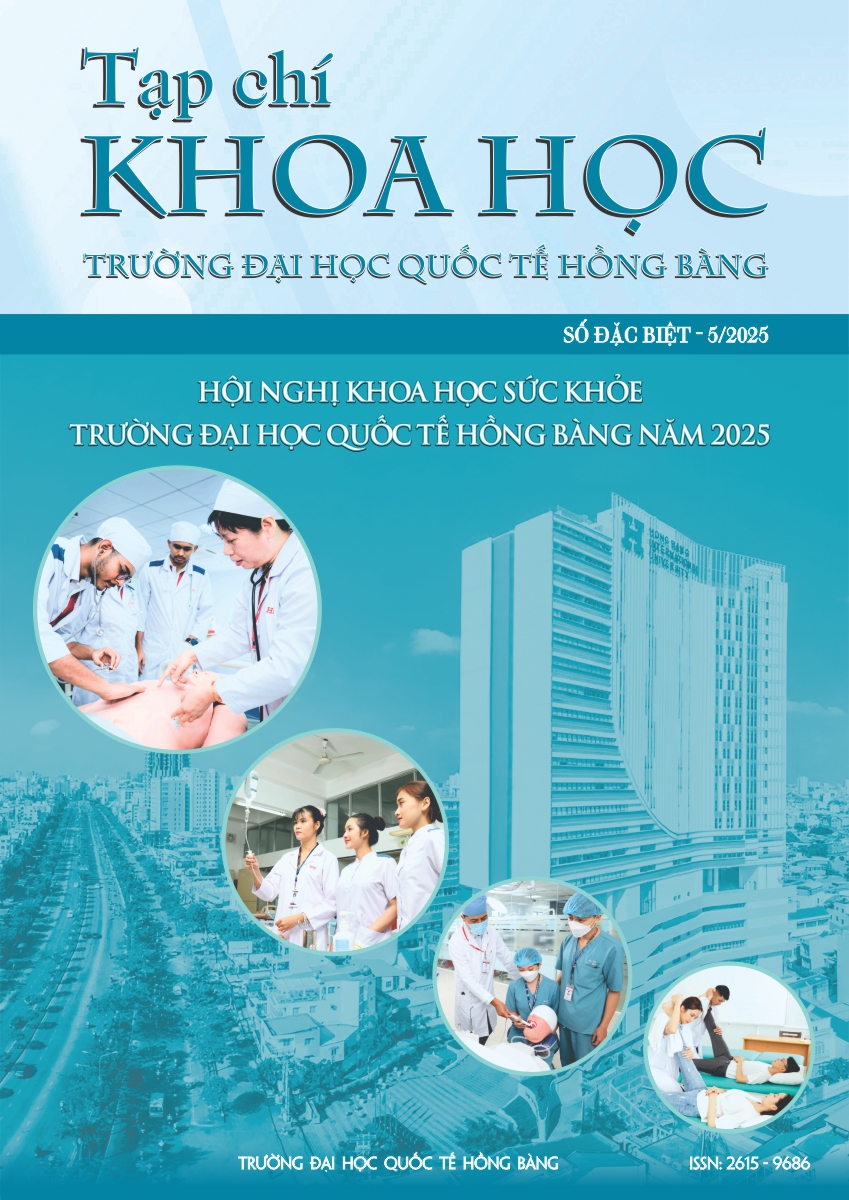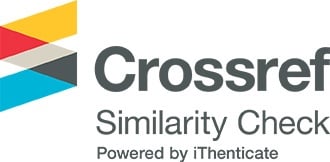ĐÁNH GIÁ HOẠT TÍNH ỨC CHẾ ENZYME α-GLUCOSIDASE CỦA ANDROGRAPHOLID TỪ PHÂN ĐOẠN ETHYL ACETATE CỦA XUYÊN TÂM LIÊN (Andrographis paniculata (Burm.f.) Nees)
Các tác giả
DOI: https://doi.org/10.59294/HIUJS.KHSK.2025.022Từ khóa:
Andrographis paniculata, andrographolid, ức chế α-glucosidaseTóm tắt
Đặt vấn đề: Y học cổ truyền Việt Nam đã phát triển mạnh mẽ với nhiều dược liệu quý, trong đó Xuyên tâm liên (Andrographis paniculata (Burm.f.) Nees) được biết đến với nhiều công dụng như kháng viêm, bảo vệ gan, hạ đường huyết và gần đây được quan tâm nhờ khả năng chống lại virus SARS-CoV-2. Mục tiêu nghiên cứu: Đánh giá khả năng ức chế enzyme α-glucosidase của các cao chiết và andrographolid phân lập từ phân đoạn ethyl acetate của cây Xuyên tâm liên. Phương pháp nghiên cứu: Sơ bộ thành phần hoá học bằng phương pháp I. Ciuley cải tiến, chiết xuất và phân lập bằng các phương pháp sắc ký, xác định chất tinh khiết bằng các phổ NMR và MS và khảo sát hoạt tính ức chế α-glucosidase. Kết quả: Cao ethyl acetate có hoạt tính mạnh hơn so với các phân đoạn khác, cho thấy khả năng tập trung các hợp chất có tác dụng sinh học trong phân đoạn này. Hợp chất andrographolid được xác định thông qua phân tích phổ NMR và thử nghiệm hoạt tính sinh học cho thấy nó có khả năng ức chế α-glucosidase ở mức 44.28%. Điều này cho thấy tác dụng của cây Xuyên tâm liên có thể đến từ sự kết hợp của nhiều hợp chất thay vì chỉ riêng andrographolid. Kết luận: Nghiên cứu này cung cấp thêm bằng chứng về tiềm năng của Xuyên tâm liên trong hỗ trợ kiểm soát đường huyết, tuy nhiên, cần nghiên cứu thêm về các hợp chất khác và đánh giá tác động hiệp đồng của chúng. Đồng thời, cần tiến hành thêm các thử nghiệm in vivo và lâm sàng để xác định tiềm năng ứng dụng thực tế của các hợp chất từ Xuyên tâm liên.
Abstract
Introduction: Traditional Vietnamese medicine has developed significantly with the use of many valuable medicinal plants. Among them, Andrographis paniculata (Burm.f.) Nees, commonly known as "Xuyen tam lien," is well-known for its various pharmacological activities including anti-inflammatory, hepatoprotective, hypoglycemic effects, and more recently, its potential against the SARS-CoV-2 virus. Objective: This study focuses on the isolation and evaluation of the α-glucosidase inhibitory activity of crude extracts and the isolated compound andrographolide from from the ethyl acetate fraction of Andrographis paniculata. Method: Preliminary phytochemical screening was conducted using a modified Ciulei method. Extraction and isolation were performed using chromatographic techniques. The purified compounds were identified based on NMR and MS spectral data. The α-glucosidase inhibitory activity was then evaluated in vitro. Results: The ethyl acetate extract exhibited stronger inhibitory activity compared to other solvent fractions, suggesting that bioactive compounds are concentrated in this fraction. The compound andrographolide was identified through NMR analysis, and bioassays revealed its α-glucosidase inhibitory activity at 44.28%. These findings indicate that the antidiabetic effect of Andrographis paniculata may result from the synergistic action of multiple constituents rather than andrographolide. Conclusion: This study provides additional evidence for the potential of Andrographis paniculata in supporting blood glucose regulation. However, further investigations on other bioactive constituents and their synergistic interactions are necessary. In vivo studies and clinical trials are also required to determine the practical application potential of compounds from Andrographis paniculata.
Tài liệu tham khảo
[1] A. S, "Andrographis paniculata: a review of pharmacological activities and clinical effects," Alternative Medicine Review, vol. 16, 11, pp. 66-77, 2011.
[2] Đ. H. Bích, Cây thuốc và động vật làm thuốc ở Việt Nam. NXB Khoa học và Kỹ thuật, 2006.
[3] U. Z. Hossain M. D., Sule, A., and Rahman K. M. , "Andrographis paniculata (Burm. f.) Wall. ex Nees: a review of ethnobotany, phytochemistry, and pharmacology," The Scientific World Journal, 2014.
DOI: https://doi.org/10.1155/2014/274905[4] Kumar S, Singh B, Bajpai V. Andrographis paniculata (Burm.f.) Nees: “Traditional uses, phytochemistry, pharmacological properties and quality control/quality assurance.” J Ethnopharmacol. 275:114054, 2021
DOI: https://doi.org/10.1016/j.jep.2021.114054[5] S. A. Sa-Ngiamsuntorn K, Pewkliang Y, Thongsri P, Kanjanasirirat P, Manopwisedjaroen S, Charoensutthivarakul S, Wongtrakoongate P, Pitiporn S, Chaopreecha J, Kongsomros S, Jearawuttanakul K, Wannalo W, Khemawoot P, Chutipongtanate S, Borwornpinyo S, Thitithanyanont A, Hongeng S, "Anti-SARS-CoV-2 Activity of Andrographis paniculata Extract and Its Major Component Andrographolide in Human Lung Epithelial Cells and Cytotoxicity Evaluation in Major Organ Cell Representatives," J Nat Prod, vol. 84, 4, pp. 1261-1270, 2021.
DOI: https://doi.org/10.1021/acs.jnatprod.0c01324[6] Biswa Deepak Bharati, Pramod Kumar Sharma, Nitin Kumar, Rupesh Dudhe and Vipin Bansal, “Pharmacological Activity of Andrographis Paniculata: A Brief Review”, Pharmacologyonline 2: 1-10, 2011.
[7] T. Hùng, Giáo trình phương pháp nghiên cứu dược liệu. Đại học Y Dược Thành phố Hồ Chí Minh, 2017.
[8] Q. G. Chen LX, Qiu F, "Studies on diterpenoids from Andrographis paniculata," Zhongguo Zhong Yao Za Zhi, vol. 31, no. 19, pp. 1594-1597, 2006.
[9] L. B. N. Phương, "Khảo sát khả năng ức chế enzyme α-glucosidase từ cao chiết lá Sầu đâu (Azadirachta indica A. Juss) tỉnh An giang," presented at the Hội nghị công nghệ sinh học toàn quốc 2022.
[10] P. V. T. Huỳnh Văn Hóa, Nguyễn Ngọc Hạnh, "Phân lập andrographolid và neoandrographolid từ cây Xuyên tâm liên (Andrographis paniculatanees)," Tạp chí Khoa học vol. 10, pp. 25-30, 2008.
[11] R. M. Moorthy NS, Fernandes PA., "Prediction of the relationship between the structural features of andrographolide derivatives and α-glucosidase inhibitory activity: a quantitative structure-activity relationship (QSAR) study," J Enzyme Inhib Med Chem, vol. 26, no. 1, pp. 78-87, 2011.
DOI: https://doi.org/10.3109/14756361003724760[12] R. E. Candra Irawan, Ismail, Maman Sukiman, Imalia Dwi Putri, Andita Utami, Lintannisa Rahmatia, Anisa Lisandi, "Effects of Solvent Variation on The Antioxidant, Anti-Inflammatory, and Alpha Glucosidase Inhibitory Activity of Andrographis paniculata (Burm.f.) Wall Leaves Extract," Trop J Nat Prod Res, vol. 8, no. 1, pp. 5968-5972, 2024.
DOI: https://doi.org/10.26538/tjnpr/v8i1.36[13] A. M. Subramanian R, Sadikun A., "In vitro alpha-glucosidase and alpha-amylase enzyme inhibitory effects of Andrographis paniculata extract and andrographolide," Acta Biochim Pol, vol. 55, 2, pp. 391-398, 2008.
DOI: https://doi.org/10.18388/abp.2008_3087Tải xuống
Tải xuống: 139











